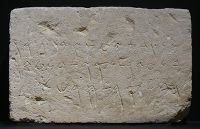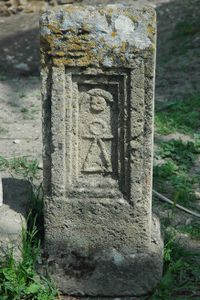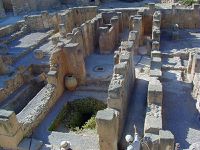How did the Phoenicians contribute to western civilization
The Phoenicians are among the most influential people in the Ancient world. These people decisively shaped the culture and the economy of the Levant and greatly influenced the Ancient Greeks, Etruscans, Hebrews, and many others. Sadly, we only know them from the writings of other cultures. Among their contributions to civilization was the development of a phonetic alphabet and a pan-Mediterranean economy. They pioneered new political systems that influenced other civilizations in the Middle East. Their neighbors also adopted many of their cultural practices. They helped create the Classical World that was centered on the Mediterranean, which gave birth to the Western world.
The history of the Phoenicians
The Phoenicians were a Semitic people who primarily inhabited what is now Lebanon, but they may also have lived in parts of modern Syria and Isreal. Archaeological evidence indicates that they were related to the Ancient people of the Levant, known as Canaanites, in the Bible.
The Phoenicians emerged in history about 1800 BC, during the Bronze Age. They occupied a narrow strip of coast, and stronger kingdoms and Empires surrounded them. [1] Because they had limited land they became highly urbanized society that relied on seafarers and merchants to survive. Tyre, Sidon, Arwad, Berytus, and Byblos were the most important cities in Phoenicia.
While Phoenicia started as a monarchy over time, it developed a sophisticated and innovative political system. The cities were often rivals’ but often cooperated on maritime and trading matters and sometimes formed a league of city-states. At times one urban center would dominate the others as was the case with Tyre, which dominated Phoenicia in the 9th century BC.
The wealth of the cities meant that predatory kings often targeted them. The Phoenicians came under the sway of the Pharaohs until about 1250 BC. The invasions of the Sea-peoples led to the collapse of the Egyptian Empire. This led to the economic and cultural flourishing of the Phoenicians. Based on the archaeological evidence, it seems that there was a great deal of continuity in Phoenician society and culture, but they also absorbed Babylonian and Egyptian influences.[2]The urban population in Phoenicia exploded in the 9th and 8th centuries BC. They had already established a number of trading posts from Spain to the Levant, which they then expanded into colonies. In 814 BC, colonists from Tyre settled in what became Carthage, during the reign of King Pygmalion. The kings of Tyre were able to establish an informal empire that included all of the Phoenician colonies in the Mediterranean. The Phoenicians remained the dominant sea power in the Levant even when they became the vassals of the neo-Assyrian Empire. However, the rise of the Persian Empire was to end the golden age of Phoenicia especially after the capture of Tyre in 585 BC, by Cyrus the Great. Despite this, the Phoenicians remained wealthy and remained maritime powers, because they had a great deal of autonomy, even under Persian domination. The decline of the Phoenicians was gradual, and they eventually lost all their autonomy in the aftermath of the conquests of Alexander the Great. They became Hellenized, over the years they lost their cultural and religious identity[3].
Phoenician economy, society, and religion
The Phoenicians were great explorers and it is believed that Hanno, explored the west coast of African in the 7th century BC. There are even some sources that argue that they visited Britain and Ireland. The city-states had large fleets and they pioneered the development of the multi-tiered oared galley, which was the most advanced ship in the period. The Phoenicians became great sailors in an effort to secure resources and to engage in commerce. The economies of cities such as Tyre were dependent on manufacturing and trade. They exported cedar wood all over the Mediterranean and were renowned for their production of purple dyes, which were very popular with ancient monarchs. The Phoenicians, like the Hebrews, who were related people, were very religious people. Their chief god was Baal and many of the Phoenician gods derived from the religion of the Canaanites. Each city has its own titular deity, for example, Melqart was the patron deity of Tyre [4]. It has been claimed that they practiced human sacrifice and in particular, they sacrificed children at a site known as a Tophet, but this is rejected by some historians. Religious fraternities were very important in Phoenician social and commercial life.
Phoenician art and culture
The Phoenicians were famous artists and Homer in the Odyssey praises their craft persons and artisans [5]. They utilized traditional Canaanite styles and designs. Like many other urban cultures they were receptive to new ideas and artistic styles, for example, they adopted the Egyptian-style of sarcophagi. There is as such no single distinctive Phoenician artistic style, but they did develop new skills and transmitted the art of other peoples across the Levant. Artistic works made in cities such as Sidon were exported all over the Mediterranean to Carthaginian outposts and they influenced local artists. The Phoenicians played a very important role in the development of the First Jewish Temple, built by King Solomon, artisans sent by the King of Tyre helped in its construction. The cities of Phoenicia played a critical role in the artistic development of the Levant and beyond[6].
The Phoenician Alphabet
Perhaps the most important cultural innovation of the Phoenicians was the development of the alphabet around 1000 BC. It appears that the Canaanites had developed the first phonetic alphabet and it was used by several peoples such as the Moabites. Based on the evidence it would appear that the Phoenicians contributed to the development of this alphabet and it appears that they used it widely in their commercial enterprises. They helped to popularize the use of the alphabet and many cultures including the Greeks and Hebrews adopted it. Over time, many national languages used their writing system. This alphabet was one of the most important inventions in all of human history. It was different from hieroglyphs, used by many societies in the Levant as it was not based on signs, but on the sounds of speech that people made. The consonants were combined with vowels to form words and sentences and allowed individuals to engage in much more complex communications than previously. This allowed bureaucrats and others to keep more effective records and made governments more efficient. Ordinary people, such as traders could learn the alphabet and become literate, which revolutionized many aspects of life. The impact of this system for writing was to have a profound impact on the Greeks, they adopted it, as they emerged from their Dark Ages. Scholars believe that the Hebrew alphabet is a regional variant of the one used in Phoenicia. Today, the script developed and transmitted by the inhabitants of cities such as Sidon, Tyre and Byblos, forms the basis for most of the globe’s alphabets[7].
Phoenicians: first democrats?
As was the case with other urban and mercantile societies Phoenicia developed sophisticated political systems. The governments of these city-states was initially organized around kings, the priesthood and a council of elders. These increasingly became oligarchic in nature over time. The Phoenicians were among the first to develop political institutions other than that of monarchy in the Levant. There are those who claim that they introduced a limited form of democracy, centuries before the Greeks. There is evidence that during religious festivities that citizens of cities such as Sidon would vote for candidates for the assembly. These democratic practices were transmitted to outposts such as Carthage. We can have a better understanding of the nature of Punic institutions by studying the constitution of Carthage. It was an oligarchical republic where citizens could elect two presidents called Suffetes. It even had a popular assembly and trade unions. The Phoenician’s political system is deemed to have been very influential in the development of governments in the Classical period. There are those who claim that Greek city-states such as Athens were influenced by the governments of cities such as Sidon and Tyre. It is also possible that they also introduced democratic institutions and practices to the Etruscans who later transmitted them to the Romans [8].
The creation of a Mediterranean economy
The Phoenicians were renowned traders and sailors. They traded all over the Mediterranean and even in the Black Sea. They traded luxury goods and high-value products such as the famous purple dye, far and wide. Traders from Sidon and other cities voyaged great distances to obtain metals such as bronze and tin. These were sourced in the mysterious land of Taresh, which is believed to have been located in modern Spain. The Phoenicians and the colonies helped to create a trade network that traversed the Mediterranean Sea and beyond. This helped the region to recover from the collapse of civilizations associated with the Sea Peoples. However, the Phoenicians were not just traders, they were also notorious pirates and slavers. Nonetheless, city-states such as Tyre made a crucial contribution to the development of international trade. What is more, the commercial networks of the Phoenicians allowed for the exchange and transmission of ideas. Historians believe that they influenced other cultures, especially with regard to religion. The Greek goddess Aphrodite was based on the cult of Astarte, which was widely practiced in Phoenicia [9].
Carthage
By the 5th century BC, the small trading outpost had developed into a powerful city. It was the leading maritime and commercial power in the Western Mediterranean. It was under the control of Tyre until it was conquered by the Persians. The Carthaginians freed from the influence of Phoenicia conquered the other Punic outposts and eventually dominated much of the North Africa coast and many of the Mediterranean islands [10]. Carthage retained its Phoenician culture and institutions and influenced many societies in the region, down the centuries. They were the rivals of the Greeks in Sicily and elsewhere and later they proved to be the greatest enemy of Rome. The Carthaginians fought three wars with Rome, known as the Punic Wars and they were ultimately to determine the fate of the Mediterranean World for centuries. If they had prevailed over Rome, the history of the Western World could have been much different. Despite their defeat and the eventual destruction of the city in 154 BC, it left an enduring legacy. They introduced new agricultural methods and naval technologies into the region, which were adopted by Rome. Moreover, they developed a rich civilization and economy on the North African littoral [11]. This area after the Third Punic War was occupied by the Romans and it became crucial for their economy. Moreover, many Punic communities continued to prosper, such as that at Utica. Many remained proud of their Phoenician ancestry, such as one of the greatest of all Christian thinkers, St Augustine. Indeed, it was only with the collapse of the Western Roman Empire, that Punic culture and language, vanished, from the region [12]. The Phoenicians through their colony at Carthage alter the course of history in North Africa.
Conclusion
Phoenicia is a civilization that is little appreciated today, unlike those of Greece and Rome. This was because it and its colonies were subjugated by other powers and its libraries and records nearly all destroyed. This means that their contributions to ancient civilization and history has often not been recognized. Among their many achievements the Phoenicians pioneered new commercial networks and introduced urban living into many areas of the Mediterranean for the first time. The Phoenicians introduced the phonetic alphabet to many societies’ and this was to revolutionize many cultures and this changed the history of the World. The unique societies of Phoenicia meant that they were among the first to develop democratic institutions and these were possibly emulated by the Ancient Greeks. Their colonization of the Mediterranean was important. The Phoenician trading post of Carthage eventually became an Empire that was pivotal in the history of the Classical World.
Further Reading
Clifford, R. J. (1990). Phoenician religion. Bulletin of the American Schools of Oriental Research, 279(1), 55-64. Millar, F. (1983). The Phoenician cities: a case-study of Hellenisation. The Cambridge Classical Journal, 29, 55-71. Markoe, G. E. (1990). The emergence of Phoenician art. Bulletin of the American Schools of Oriental research, 279(1), 13-26. Oded, B. (1974). The Phoenician cities and the Assyrian Empire in the time of Tiglath-pileser III. Zeitschrift des Deutschen Palästina-Vereins (1953-), (H. 1), 38-49.
References
- Jump up ↑ Moscati, Sabatino The World of the Phoenicians (NY: Frederick A. Praeger, 1995, p. 34)
- Jump up ↑ Moscati, p 14
- Jump up ↑ Moscati, p 14
- Jump up ↑ Clifford, Richard J. "Phoenician religion." Bulletin of the American Schools of Oriental Research 279, no. 1 (1990): 55-64
- Jump up ↑ Homer, Odyssey, iii, 67
- Jump up ↑ Moscati, p 14
- Jump up ↑ Diringer, David, and H. Freeman. A History of the Alphabet (London, Unwin Brothers, 1977), p. 8, 89, 112
- Jump up ↑ Stockwell, Stephen. "Before Athens: Early popular government in Phoenicia and Greek city-states." In The Secret History of Democracy, pp. 35-48. Palgrave Macmillan, London, 2011
- Jump up ↑ Sherratt, Susan, and Andrew Sherratt. "The growth of the Mediterranean economy in the early first millennium BC." World Archaeology 24, no. 3 (1993): 361-378
- Jump up ↑ Astin, A. E., M. W. Frederiksen, R. M. Ogilvie, and F. W. Walbank, eds. The Cambridge ancient history. Cambridge University Press, 1984), p. 117
- Jump up ↑ Astin, p. 201
- Jump up ↑ Astin, p. 213



